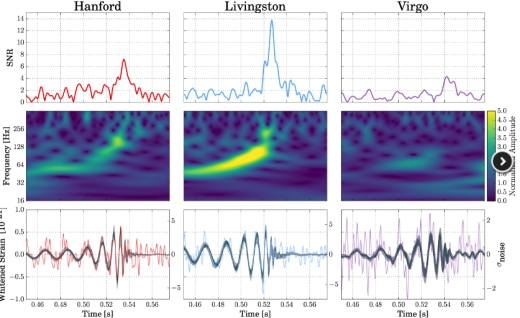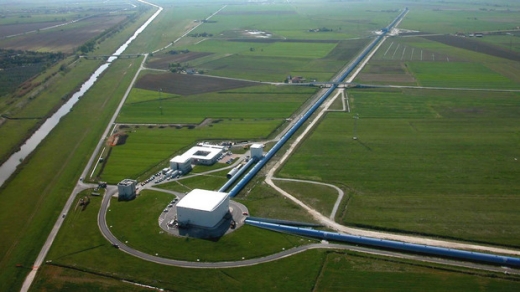What we get with yesterday’s gravitational wave announcement isn’t a breakthrough in itself. After all, this is not the first but the fourth detection of a black hole merger, so as we enter the era of gravitational wave astronomy, we’re beginning to build our catalog of exotic objects.
But the gravitational wave known as GW170814 is significant because of the addition of the Virgo Gravitational-Wave Observatory to our toolkit. We ramp up our capabilities at locating the objects we detect in the sky when we factor in this new detector. Thus Chad Hanna (Penn State), who served as co-chair of the group within LIGO (Laser Interferometer Gravitational-Wave Observatory) that made all previous detections:
“It is our hope to one day detect gravitational waves and to simultaneously observe the source of the gravitational waves with conventional telescopes so that we might learn even more about what causes the gravitational waves. In order to do that, we need to know where to look. LIGO and Virgo together allow us to pinpoint the gravitational wave source in the sky far better than before, which will dramatically improve our chances of capturing the gravitational wave source with other telescopes.”

Image: Top row: Signal-to-noise ratio as a function of time. The peaks occur at different times in different detectors because gravitational waves propagate at the finite speed of light; this causes the signal to reach the detectors at different times. GW170814 arrived first in LIGO-Livingston, then 8 ms later in LIGO-Hanford and 6 ms after that in Virgo. Middle row: Time-frequency representation of the strain data. The brighter a given pixel in any of the three 2D-maps, the larger the signal at this particular time and frequency with respect to the expected noise level. Note the characteristic “chirp” pattern of increasing frequency with time. Bottom row: Strain time series with the best waveforms selected by the matched filtering (black solid curves) and unmodeled search methods (gray bands) superimposed. Credit and copyright: LIGO Scientific Collaboration and Virgo Collaboration.
Gravitational wave astronomy is less than two years old, but we’re adding substantial resources to the investigation with the addition of the Virgo detector. Located near Pisa, the Italian effort involves more than 280 physicists and engineers in 20 different European research groups. The Virgo detector took data jointly with the two LIGO observatories, one in Livingston, Louisiana and the other at Hanford in Washington state, in a network that also included contributions from the Anglo-German GEO600 instrument near Hanover.
The network observed GW170814 on August 14, only two weeks after the Virgo detector began taking data. Subsequent analysis showed that the event marked the merger of two black holes of 31 and 25 solar masses respectively, occurring at a distance of 1.8 billion light years. The newly produced black hole is thought to have 53 times the mass of the Sun, with three solar masses being converted into gravitational wave energy during the coalescence of the constituent black holes.
And here is where the triangulation comes in. The gravitational wave arrived at the Livingston detector some 8 milliseconds before the LIGO detector at Hanford, and some 14 milliseconds before reaching the Virgo detector. Combined arrival time delays allows the direction toward the source to be determined. Researchers are saying they can trace it down to a patch of 60 square degrees in the southern sky between the constellations Eridanus and Horologium. Moving from a two- to three-detector network shrinks the volume of sky likely to contain a source by more than a factor of 20, according to this LIGO Scientific Collaboration news release.

Image: The Virgo Observatory. Credit: The Virgo collaboration/CCO 1.0.
The search for an analog to the gravitational wave event produced no detection at electromagnetic wavelengths, although 25 observatories searched at wavelengths ranging from gamma, optical, infrared, x-ray, and radio as well as neutrino emissions. The lack of an electromagnetic detection was not surprising, because although collisions of neutron stars are thought likely to produce light emissions as well as gravitational waves, black hole mergers produce gravitational waves but not light.
Scientists at the Albert Einstein Institute in Potsdam and Hanover ruled out random noise fluctuations, finding the signal to be real with a probability of more than 99 percent. The Hanover team developed many of the software algorithms used in the analysis of LIGO data.
A third observatory ensures that future detections will be accompanied by a search for the source at all these wavelengths as we begin to extend gravitational wave astronomy into events beyond black hole collisions.
“This is just the beginning of observations with the network enabled by Virgo and LIGO working together,” says David Shoemaker of MIT, LIGO Scientific Collaboration spokesperson. “With the next observing run planned for Fall 2018 we can expect such detections weekly or even more often.”
The paper on this event, accepted at Physical Review Letters, is LIGO Scientific Collaboration and The Virgo Collaboration, “GW170814 : A three-detector observation of gravitational waves from a binary black hole coalescence” (available online).



By my standards of proof, Virgo + LIGO counts as the first confirmed GW detection. But I am old school.
What about LIGO, VIRGO, and an electromagnetic confirmation? Would that meet your ‘standards of proof’? ;)
The black hole merger events to date are between large ones that are close to the same mass. This is selection bias that is not representative of the population of BH or BH binaries.
http://www.ligo.org/detections/images/BHmassChartGW17.jpg
The bias is due to LIGO’s sensitivity and especially the nature of BH mergers. Gravitational radiation is greatest when the masses of the merging objects is equal. It falls off very rapidly as their size ratio increases. From what I’ve read on LIGO their detection algorithms and models are, so far, mainly focused on ratios no greater than 4 for this reason. Mergers of smaller masses and greater mass ratios are relatively rare events within LIGO’s current range. Even then the signal-to-noise ratios are modest.
When LIGO’s sensitivity increases next year the probability of catching BH mergers of smaller mass and greater mass ratios increases. It’ll be some time yet before we get a statistically reliable empirical picture of what’s going on out there.
Detection of merging non-BH compact objects is especially challenging. Worse yet are detections of a non-BH compact object (e.g. neutron star) merging with a BH. It’s early days.
Neutron star pair seen merging for the first time:
http://www.eso.org/public/news/eso1733/
http://www.spacetelescope.org/news/heic1717/
http://www.gemini.edu/node/12719
http://www.dunlap.utoronto.ca/neutron-star-merger-source-of-gravitational-waves/
Merging neutron stars emit both gravitational waves and light
http://www.spaceflightinsider.com/missions/space-observatories/merging-neutron-stars-emit-gravitational-waves-light/
A possible literal roadblock for conducting Neutrino SETI/METI: Earth itself…
http://earthsky.org/earth/earth-blocks-neutrinos-icecube-south-pole?mc_cid=5faffe309b&mc_eid=719b90ecbf
To quote:
It used to be said that neutrinos were massless and would pass through anything. But in recent years, scientists have realized that these strange particles – some of which were formed in the first second of the early universe, and which travel at the speed of light – are only practically massless. And now it’s been proven experimentally, by scientists working with data at the IceCube detector at Earth’s South Pole, that very energetic neutrinos can, in fact, be blocked. Doug Cowen at Penn State University was a collaborator on the study. He said:
This achievement is important because it shows, for the first time, that very-high-energy neutrinos can be absorbed by something — in this case, the Earth.
The results of this recent experiment were published in the online edition of the peer-reviewed journal Nature on November 22, 2017.
The Gaia Mission Could Moonlight as a Gravitational Wave Detector
https://www.universetoday.com/138204/gaia-mission-moonlight-gravitational-wave-detector/